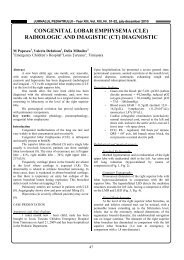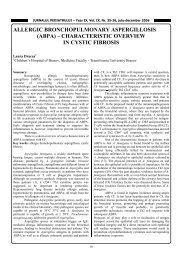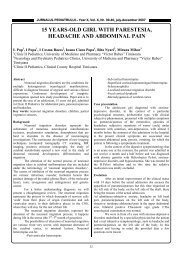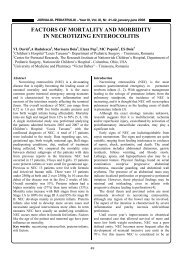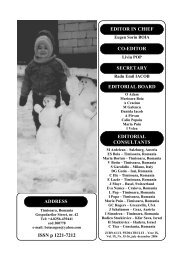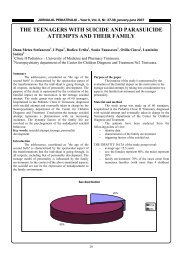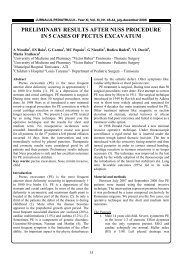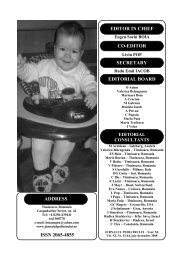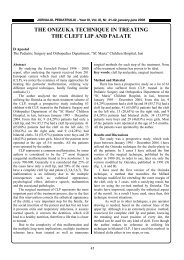THE DIAGNOSIS AND PROPHYLAXIS OF THE IRON DEFICIENCY ...
THE DIAGNOSIS AND PROPHYLAXIS OF THE IRON DEFICIENCY ...
THE DIAGNOSIS AND PROPHYLAXIS OF THE IRON DEFICIENCY ...
You also want an ePaper? Increase the reach of your titles
YUMPU automatically turns print PDFs into web optimized ePapers that Google loves.
JURNALUL PEDIATRULUI – Year XIV, Vol. XIV, Nr. 53-54, january-june 2011<br />
<strong>THE</strong> <strong>DIAGNOSIS</strong> <strong>AND</strong> <strong>PROPHYLAXIS</strong> <strong>OF</strong><br />
<strong>THE</strong> <strong>IRON</strong> <strong>DEFICIENCY</strong> <strong>AND</strong> <strong>IRON</strong> <strong>DEFICIENCY</strong><br />
ANEMIA IN BABIES <strong>AND</strong> SMALL CHILDREN<br />
Carmen Elena Niculescu¹, Ileana Puiu¹, Laura Marinău¹, D Niculescu², Eleonora Iordache¹<br />
Abstract<br />
The work refers to the diagnosis and prophylaxis of the<br />
iron deficiency and iron deficiency anemia in babies<br />
(naturally or artificially fed) and the children younger than 3<br />
years. The recent studies show that iron deficiency anemia<br />
and iron deficiency without iron deficiency can have long<br />
term effects on neurological development. We hereby<br />
present the adequate iron addition and the screening of iron<br />
deficiency anemia.<br />
Key words: iron deficiency, iron deficiency anemia, baby,<br />
small child, iron addition<br />
Introduction<br />
The iron deficiency and iron deficiency anemia<br />
continue to be a world health issue in the developing nations<br />
and even in the industrialized ones (2,23,28). Nevertheless,<br />
even more important than anemia is the iron deficiency<br />
without anemia which can have long term effects on the<br />
neurological development and behavior, some of them<br />
irreversible. This work refers to the diagnosis and<br />
prophylaxis of iron deficiency anemia.<br />
Definition, prevalence and necessary iron<br />
Anemia is defined as the drop in concentration of the<br />
hemoglobin under 11g/dL in children aged between 12 and<br />
36 months. In certain populations (such as the ones leaving<br />
at high altitudes) the value adjustment must be done.<br />
The normal iron concentration is the situation in which<br />
there is enough iron to maintain the physiological functions<br />
within normal limits. The iron deficiency is the situation in<br />
which there is not enough iron to maintain the physiological<br />
functions within normal limits. The iron deficiency is the<br />
result of the inadequate absorption of iron reported to the<br />
needs or of the negative balance of iron on long term. Each<br />
of these situations leads to the decrease in the iron deposits<br />
measured in serum ferritin or in the iron concentration in the<br />
bone marrow. The iron deficiency may or may not be<br />
accompanied by iron deficiency anemia. The iron deficiency<br />
anemia is the anemia resulting from the iron deficiency<br />
(2,16,18).<br />
The iron overload is the excessive accumulation of iron<br />
in the tissues. The iron overload is usually the result of the<br />
genetic predisposition to excessively absorb and store iron<br />
(e.g. hereditary hemochromatosis). The iron overload may<br />
also be a complication in other hematologic diseases that<br />
need repeated blood transfusions, repeated iron injections or<br />
excessive iron ingestion.<br />
The recommended iron diet is the average of the daily<br />
iron needs that is enough for almost all individuals, based on<br />
age and gender. The adequate iron need is the term used<br />
when there is not enough information to establish the<br />
recommended diet for certain population segments<br />
(newborns, babies younger than 6 months)<br />
80% if the iron quantity of the new born at birth is<br />
formed during the last pregnancy trimester. The premature<br />
newborn “skips” this period and has an iron deficiency.<br />
Certain diseases of the mother, such as anemia, sugar<br />
diabetes, arterial hypertension with in-uterus growth<br />
deficiency, can lead to low iron deposits in the newborns<br />
born on time, as well as the premature ones. The iron<br />
deficiency in premature babies increases with the decrease<br />
of the gestational age and is worsened by the frequent<br />
phlebotomies without adequate blood replacement. On the<br />
other hand the premature babies who receive multiple blood<br />
transfusions run the risk of iron overload. The varying status<br />
in blood in premature babies, with the risk of iron deficiency<br />
or toxicity, makes the determination of the exact needs<br />
impossible, which is estimated at 2-4 mg/day if administered<br />
orally (1,12,28).<br />
IOM (Institute of Medicine), taking into account the<br />
average iron content of the human milk, has determined the<br />
adequate intake at 0.27 mg/day in full term newborns since<br />
birth until 6 months of age (16).<br />
The average of the iron content of the human milk if<br />
0.37 mg/L and the average of the milk needs of the<br />
exclusively fed baby is estimated at 0.78 L/day. From these<br />
valued the necessary amount has been determined at 0.27<br />
mg/day for the full term newborn until 6 months of age.<br />
IOM has considered that there must be a direct connection<br />
between the age of the baby and the milk ingestion; thus<br />
there must not be any correlation based on weight.<br />
Nevertheless, there is a large variation in the iron<br />
concentration in human milk and there is no guarantee that it<br />
will cover the needs of the baby. For the babies between 6<br />
and 12 months the recommended diet for iron (according to<br />
IOM) is of 11 mg/day (16).<br />
¹Pediatric Department, University of Medicine and Pharmacy Craiova<br />
²Orthopedy and Traumatology Department, University of Medicine and Pharmacy Craiova<br />
E-mail: niculescudragos@yahoo.com, vipuiu@yahoo.com, marinau_doru@yahoo.co.uk, niculescudragos@yahoo.com,<br />
eleonora_iordache2@yahoo.com<br />
21
JURNALUL PEDIATRULUI – Year XIV, Vol. XIV, Nr. 53-54, january-june 2011<br />
The amount of iron losses – the epithelial exfoliation of<br />
the skin, the urinary and digestive tracts – was added to the<br />
amount of the iron needs for the increase of the blood<br />
volume with the growth of tissue mass and to the iron<br />
deposits of that period. It is mentioned that the necessary<br />
iron in babies does not pass directly from 0.27 mg/day to 11<br />
mg/day at the age of 6 months. It is obvious that the full<br />
term healthy newborn needs very little iron in the first 6<br />
months as compared to the needs after 6 months (16,25).<br />
Using the same reasoning, IOM considers that that<br />
recommended necessary iron for the child aged 1-3 is of 7<br />
mg/day.<br />
There is no national statistic on the prevalence of iron<br />
deficiency and iron deficiency anemia in babies. The general<br />
prevalence in the USA of iron deficiency anemia has<br />
dropped in babies and small children since the 1970s, with<br />
the use of iron-enriched milk formulae and with the drop of<br />
the use of cow milk in babies (2). Related the iron<br />
deficiency anemia is the issue of the interaction between<br />
iron and led. If the studies made on animals and humans it<br />
has been noticed that the iron deficiency anemia increases<br />
the intestinal absorption of led. Thus, iron deficiency anemia<br />
decreases the efficiency of lead chelators and the iron<br />
supplements correct this issue (7,38).<br />
Many studies have shown the connection between iron<br />
deficiency anemia and later cognitive deficiencies. Lozoff et<br />
colab. (2006) have shown the cognitive deficiencies in the<br />
1-2 decades after iron deficiency during the baby stage (18).<br />
Nevertheless, it is difficult to determine a causality<br />
connection. It is known that iron is essential in neurological<br />
development. The iron deficiency affects the neuronal<br />
metabolism, the neurotransmitter metabolism, the<br />
mielinisition and memory (6,11,30). These observations<br />
could explain the behavioral problems in children with iron<br />
deficiency.<br />
Paraclinical diagnosis<br />
We follow certain parameters: the hemoglobin<br />
concentration, the reticulocites, erythrocitary indexes, the<br />
total iron assimilation, the transferrine saturation,<br />
protoporphyrine, ferritine and sTfr (transferrine receptor).<br />
The last parameter, the soluble form of the transferrine<br />
receptor that freely travels into the plasma, is an important<br />
indicator of the status of iron in the organism.<br />
In this table we show the changed in the main<br />
parameters.<br />
Parameter<br />
Iron deficiency without Iron deficiency anemia Iron overload<br />
anemia<br />
Ferritine ↓ ↓↓ ↑<br />
Transferrine saturation ↓ ↓ ↑↑<br />
Transferrine receptor ↑↑ ↑↑↑ ↓<br />
(sTfr)<br />
Reticulocitary hemoglobin ↓ ↓ Normal<br />
Hemoglobin normal ↓ Normal<br />
VEM normal ↓ normal<br />
↓ low value, ↑ high value<br />
The iron status in children is not determined by a simple<br />
determination of hemoglobin concentration. The decrease in<br />
hemoglobin can have a variety of causes, of which we<br />
mention the hemolitical anemia, the chronic disease anemia,<br />
the B12 or folic acid deficiency anemia, the genetic disease<br />
anemia. But once put the iron deficiency diagnosis, the<br />
supervision of the hemoglobin concentration is a good<br />
response measure to the treatment.<br />
Any set of analysis will include the hemoglobin<br />
concentration to determine whether or not there is anemia.<br />
The three parameters giving selective data about the status<br />
of the iron are: ferritine, reticulocitary hemoglobin and the<br />
transferrine receptor.<br />
Ferritine is a sensitive parameter for the assessment of<br />
the iron deposits in healthy subjects (1 µg/L of ferritine<br />
corresponds to 8-10 mg of available iron). In children the<br />
value showing the depletion of the iron deposits is of 10<br />
µg/L (in adults 12 µg/L) (9,17). Because the serum ferritine<br />
is a short phase reactant, its concentration can be increased<br />
in the presence of chronic inflammations, infections,<br />
malignancies, hepatic diseases. A simultaneous<br />
determination of protein C reactive is needed to exclude the<br />
inflammation.<br />
Even though serum ferritine has a lower accuracy that<br />
reticulocitary hemoglobin or the transferrine recepton, the<br />
combination of ferritine and protein C reactive is more<br />
accessible and a more reliable test as long as the protein C<br />
reactive is not high (9,17,34).<br />
The reticulocitary hemoglobin and the transferrine<br />
receptor are not influenced by the inflammation,<br />
malignancy, infections, chronic diseases and are preferable<br />
for the diagnosis. The reticulocitary hemoglobin has been<br />
validated, standardized in children and actually available.<br />
This parameter provides a measurement of the available iron<br />
in the cells recently released by the bone marrow (5). The<br />
reticulocitary hemoglobin can be measured by citometric<br />
flow and the low concentration is the most important in<br />
predicting iron deficiency in children.<br />
The transferrine receptor (sTfr) is a measure of the iron<br />
status which finds the iron deficiency on a cellular level<br />
(32,37). It is found on the cell membrane and allows the<br />
transfer of iron in the cell. When the iron is insufficient,<br />
there is an imbalance of the transferrine receptor’s<br />
permission for the cell to have a more efficient iron<br />
composition and later its circular form has a serum increase.<br />
An increase in serum in the transferine receptor can be<br />
22
JURNALUL PEDIATRULUI – Year XIV, Vol. XIV, Nr. 53-54, january-june 2011<br />
found in the patients with iron deficiency or iron deficiency<br />
anemia, even though the serum doesn’t increase until the<br />
iron deposits are depleted in the adults. The assessment of<br />
the transferrine receptor is not usually available and the<br />
standard value for children has not yet been established.<br />
For putting the diagnosis of iron deficiency anemia<br />
(when a hemoglobin value smaller than 11g/dl is<br />
associated), nowadays the following tests can be used:<br />
ferritine + protein C reactive or reticulocitary hemoglobin.<br />
For the iron deficiency diagnosis without anemia the same<br />
parameters are measured.<br />
Another approach in the diagnosis of iron deficiency<br />
anemia in mild anemia children (Hb 10-11g/dL) is the<br />
monitoring of the response to iron supplements, especially if<br />
the history of the nutrition involves an iron-poor diet. An<br />
increase in hemoglobin of 1 g/dL after 1 months of<br />
treatment is used as positive for iron deficiency anemia.<br />
This approach imposes an adequate iron treatment, the<br />
compliance of the patient and an adequate absorption.<br />
Correcting the iron deficiency and iron deficiency anemia.<br />
Premature babies. The naturally-fed premature babies<br />
(below 37 weeks of gestational age) will receive elementary<br />
iron supplements of 2 mg/kg/day beginning with 1 month of<br />
age until 12 months. The iron can be provided through<br />
medication or through an iron-rich diet. The premature<br />
babies who are fed with formulae for premature babies (14.6<br />
mg iron/L) or ordinary formulae (12 mg iron/L) will receive<br />
approximately 1.8-2.2 mg/kg/day assuming a milk<br />
consumption of 150 ml/kg/day (12,29).<br />
Despite the iron-enriched formulae, 14% of premature<br />
babies have an iron deficiency between 4 and 8 months of<br />
age. Thus the enriched formulae need an iron supplement<br />
addition. The exception for these iron supplements are the<br />
premature babies who received multiple transfusions during<br />
the hospitalization period, who might not need iron<br />
supplements.<br />
Naturally fed full term babies. The full term baby has a<br />
higher hemoglobin concentration and a higher blood volume<br />
as compared to body weight. They go through a<br />
physiological decrease in hemoglobin and blood volume<br />
during the first four months of life. Usually the iron deposits<br />
are enough for the first 4-6 months. The iron content of<br />
human milk is enough for the newborns who are exclusively<br />
naturally fed.<br />
The exclusively natural diet is recommended for 6<br />
months. The exclusively natural diet for the newborns after<br />
6 months is connected to a higher risk of iron deficiency<br />
anemia at the age of 9 months. The recommendation for an<br />
exclusively natural diet does not take into account the babies<br />
born with low iron deposits (the newborns with a low<br />
weight at birth, the babies whose mothers have diabetes), a<br />
situation which also determines a low iron concentration at<br />
the age of 9 months.<br />
It is recommended that the full term babies who are<br />
exclusively naturally fed receive an iron supplement of 1<br />
mg/kg/day starting with the age of 4 months until the<br />
introduction of the iron-rich foods (10,25).<br />
For the mixed-fed babies, the proportion of the breastfeeding<br />
as opposed to the formulae is uncertain. Thus, after<br />
4 months the babies who do not receive an iron-rich diet will<br />
get 1 mg/kgc/day supplemental iron.<br />
Artificially fed full term babies. The American Pediatric<br />
Association has concluded that the milk formulae containing<br />
12 mg elemental iron /L are safe (26,27,31). There is not<br />
enough data to relate the formulae with 12 mg/L to the<br />
gastro-intestinal symptoms (3,12,31).<br />
Small children (1-3 years). The necessary iron in small<br />
children is of 7 mg/day. Ideally, the necessary iron must be<br />
provided through food naturally rich in iron and vitamin C<br />
which stimulates the iron absorption. In the developing<br />
countries, the necessary iron is covered by the iron<br />
strengthening of certain foods such as corn flour, soy sauce,<br />
rice, cereal. Nevertheless, there are barriers to providing an<br />
optimal iron intake: the lack of education of the parents, the<br />
low compliance to any digestive adverse effects, the price of<br />
enriched products, the federal nutrition programs which do<br />
not provide iron supplements. In the US, the iron-enriching<br />
of formulae and cereals for the babies has lead to the<br />
decrease of iron deficiency anemia (2).<br />
As an alternative for those who do not take enough iron<br />
from the diet, there are also the iron supplements which are<br />
available as a component of the multivitamin syrup or<br />
chewable tablets (4,13,14).<br />
Screening for iron deficiency and iron deficiency anemia.<br />
The universal screening must assess the risk factors<br />
associated to the iron deficiency/iron deficiency anemia: a<br />
history of premature birth or small weight at birth, exposure<br />
to led, an exclusively natural diet over 4 months without<br />
iron supplements, an integral milk diet, a diet of non-iron<br />
enriched cereal or of low-iron foods. The additional risk<br />
factors include nutrition problems, an inadequate diet, a<br />
stationary weight curve.<br />
In the US 60% of the anemia cases are not due to the<br />
iron deficiency and most of the iron deficiency children do<br />
not have anemia.<br />
Selective screening tests can be done at any age when<br />
the risk factors for iron deficiency and iron deficiency<br />
anemia are found.<br />
After determining the hemoglobin concentration, in<br />
children with hemoglobin below 11 mg/dL or with a high<br />
risk of iron deficiency the ferritine + protein C reactive and<br />
reticulocitary hemoglobin are determined. The<br />
determination of the transferrine receptor will enter the<br />
screening tests once the value in children is determined.<br />
Conclusions<br />
It is important that we eliminate the iron deficiency and<br />
iron deficiency anemia in babies and young children,<br />
considering their impact on cognitive and behavioral<br />
development(22,24,30). There are controversies regarding<br />
the time and methods of screening and on the use of iron<br />
supplements.<br />
The present data support the following<br />
recommendations:<br />
23
JURNALUL PEDIATRULUI – Year XIV, Vol. XIV, Nr. 53-54, january-june 2011<br />
• Healthy newborns born on time have enough iron for at<br />
least the first four months of life. The exclusively natural<br />
feeding after the first four months without iron supplements<br />
leads to an iron deficiency. The naturally fed babies must<br />
receive 1 mg/kg/day starting with the age of 4 months until<br />
the iron-rich foods (including cereal) are introduced in the<br />
diet.<br />
• For the mixed-fed babies, the proportion of mother milk<br />
vs. formula is uncertain. Consequently, starting with the age<br />
of 4 months the mixed-fed babies who do not receive ironrich<br />
foods must receive 1 mg elemental iron/kg/day.<br />
• For the formulae-fed babies, the necessary iron can be<br />
covered by standard milk formulae (iron content 10-12<br />
mg/L) and the introduction of foods containing iron after 4-6<br />
months of age, including cereal. The integral milk must not<br />
be used before 1 year of age.<br />
• The iron addition between 6 and 12 months must be of 11<br />
mg/day. When the food becomes more varied, the<br />
vegetables and red meat with a high iron content are<br />
introduced. If the food does not cover the necessary, the<br />
liquid iron supplements will be introduced.<br />
• The small child (1-3 years) has a necessary of iron of 7<br />
mg/day which will be provided by the red meat, ironenriched<br />
cereal, iron-rich vegetables, fruit with vitamin C<br />
which increases the iron absorption (35,36). In the case of<br />
the children who do not receive the appropriate iron-rich<br />
food, iron supplements are recommended as syrup or<br />
chewing tablets.<br />
• Premature babies must receive an iron addition of at least 2<br />
mg/kg/day until 12 months old, including the supplementary<br />
iron in the milk formulae. Naturally fed premature babies<br />
must receive iron supplements of 2 mg/kg/day after 1<br />
months of age until the diversifying with iron-rich foods<br />
(29). The exception consists of the premature babies who<br />
have received iron through blood transfusions and<br />
erythrocitary mass transfusions.<br />
• The universal anemia screening must be done at<br />
approximately 12 months with the determination of the<br />
hemoglobin concentration and the assessment of the risk<br />
factors related to the iron deficiency/ iron deficiency<br />
anemia. These risk factors include precarious socioeconomic<br />
status, a history of premature birth or small<br />
weight at birth, exposure to led, exclusively natural nutrition<br />
until 4 months of age without iron supplements, iron-rich<br />
foods and iron-enriched cereal. Additional risk factors are<br />
the eating disorders, inadequate weight gain, inadequate<br />
nutrition. In the case of babies and small children, the<br />
screening must be done whenever the risk factors are<br />
involved.<br />
• If the hemoglobin level is less than 11 mg/dL at 12 months<br />
the cause of the anemia will be investigated. If there are risk<br />
factors of iron deficiency the status of the iron will be<br />
investigated. The ferritin + reactive protein C and<br />
reticulocitary hemoglobin will be determined. Afterwards<br />
the correct treatment will be applied.<br />
• If a child has mild anemia (Hb 10-11 mg/dL) and can be<br />
closely monitored, an alternative diagnosis method will be<br />
the increase by 1g/dl of the hemoglobin concentration after a<br />
month of iron therapy.<br />
• The use of the transferrin receptor (sTfs) as screening<br />
for the iron deficiency is promising and the establishing of<br />
the standard value is expected for the use on babies and<br />
small children.<br />
References<br />
1. American Academy of Pediatrics, Committee on<br />
Nutrition. Nutritional needs of the premature infant. In:<br />
Kleinman RE, ed. Pediatric Nutrition Handbook. 6th ed.<br />
Elk Grove Village, IL: American Academy of Pediatrics;<br />
2008:79–112<br />
2. American Academy of Pediatrics, Committee on<br />
Nutrition. Iron fortification of infant formulas.<br />
Pediatrics. 1999;104(1 pt 1):119–123<br />
3. Agostoni C, Domellof M. Infant formulae: from<br />
ESPGAN recommendations towards ESPGHANcoordinated<br />
global standards. J Pediatr Gastroenterol<br />
Nutr. 2005;41(5):580–583<br />
4. Baqui AH, Zaman K, Persson LA, et al. Simultaneous<br />
weekly supplementation of iron and zinc is associated<br />
with lower morbidity due to diarrhea and acute lower<br />
respiratory infection in Bangladeshi infants. J Nutr.<br />
2003;133(12):4150–4157<br />
5. Brugnara C, Schiller B, Moran J. Reticulocyte<br />
hemoglobin equivalent (Ret He) and assessment of irondeficient<br />
states. Clin Lab Haematol. 2006;28(5):303–308<br />
6. Bruner AB, Joffe A, Duggan AK, Casella JF, Brandt J.<br />
Randomized study of cognitive effects of iron<br />
supplementation in non-anemic iron-deficient adolescent<br />
girls.Lancet 1996;348(9033):992–996<br />
7. Canfield RL, Henderson CR, Jr, Cory-Slechta DA, Cox<br />
C, Jusko TA, Lanphear PB. Intellectual impairment in<br />
children with blood lead concentration below 10 microg<br />
per deciliter. N Engl J Med. 2003;348(16):1517–1526<br />
8. Cook JD, Lipschitz DA, Miles LE, Finch CA. Serum<br />
ferritin as a measure of iron stores in normal subjects.<br />
Am J Clin Nutr. 1974;27(7):681–687<br />
9. Ferguson BJ, Skikne BS, Simpson KM, Baynes RD,<br />
Cook JD. Serum transferrin receptor distinguishes the<br />
anemia of chronic disease from iron deficiency anemia. J<br />
Lab Clin Med. 1992;119(4):385–390<br />
10. Friel JK, Aziz K, Andrews WL, Harding SV, Courage<br />
ML, Adams RJ. A double-masked, randomized control<br />
trial of iron supplementation in early infancy in healthy<br />
term breast-fed infants. J Pediatr. 2003;143(5):582–586<br />
11. Georgieff MK. The role of iron in neurodevelopment:<br />
fetal iron deficiency and the developing hippocampus.<br />
Biochem Soc Trans. 2008;36(pt 6):1267–1271<br />
12. Griffin IJ, Cooke RJ, Reid MM, McCormick KP, Smith<br />
JS. Iron nutritional status in preterm infants fed formulas<br />
fortified with iron. Arch Dis Child Fetal Neonatal Ed.<br />
1999;81(1)<br />
24
JURNALUL PEDIATRULUI – Year XIV, Vol. XIV, Nr. 53-54, january-june 2011<br />
13. Gera T, Sachdev HP. Effect of iron supplementation on<br />
incidence of infectious illness in children: systematic<br />
review. BMJ. 2002;325(7373):1142<br />
14. Iannotti LL, Tielsch JM, Black MM, Black RE. Iron<br />
supplementation in early childhood: health benefits and<br />
risks. Am J Clin Nutr. 2006;84(6):1261–1276<br />
15. Idjradinata P, Pollitt E. Reversal of developmental<br />
delays in iron-deficient anemic infants treated with iron.<br />
Lancet. 1993;341(8836):1–4<br />
16. Institute of Medicine. Dietary Reference Intakes for<br />
Vitamin A, Vitamin K, Arsenic, Boron, Chromium,<br />
Copper, Iodine, Iron, Manganese, Molybdenum, Nickel,<br />
Silicon, Vanadium, and Zinc. Washington, DC: National<br />
Academies Press; 2003<br />
17. Jacobs A, Miller F, Worwood M, Beamish MR, Wardrop<br />
CA. Ferritin in the serum of normal subjects and patients<br />
with iron deficiency and iron overload. Br Med J.<br />
1972;4(5834):206–208<br />
18. Lozoff B, Jimenez E, Smith JB. Double burden of iron<br />
deficiency in infancy and low socioeconomic status: a<br />
longitudinal analysis of cognitive test scores to age 19<br />
years. Arch Pediatr Adolesc Med. 2006;160(11):1108–<br />
1113<br />
19. Lozoff B, Jimenez E, Wolf AW. Long-term<br />
developmental outcome of infants with iron deficiency.<br />
N Engl J Med. 1991;325(10):687–694<br />
20. Lozoff B, Jimenez E, Hagen J, Mollen E, Wolf AW.<br />
Poorer behavioral and developmental outcome more than<br />
10 years after treatment for iron deficiency in infancy.<br />
Pediatrics. 2000;105(4).<br />
21. Lozoff B, De Andraca I, Castillo M, Smith JB, Walter T,<br />
Pino P. Behavioral and developmental effects of<br />
preventing iron-deficiency anemia in healthy full-term<br />
infants Pediatrics. 2003;112(4):846–854<br />
22. Logan S, Martins S, Gilbert R. Iron therapy for<br />
improving psychomotor development and cognitive<br />
function in children under the age of three with iron<br />
deficiency anemia. Cochrane Database Syst Rev.<br />
2001;(2)<br />
23. Male C, Persson LA, Freeman V, Guerra A, van't Hof<br />
MA, Haschke F; Euro-Growth Iron Study Group.<br />
Prevalence of iron deficiency in 12-mo-old infants from<br />
11 European areas and influence of dietary factors on<br />
iron status (Euro-Growth study). Acta Paediatr.<br />
2001;90(5):492–498<br />
24. McCann JC, Ames BN. An overview of evidence for a<br />
causal relation between iron deficiency during<br />
development and deficits in cognitive or behavioral<br />
function. Am J Clin Nutr. 2007;85(4):931–945<br />
25. Meinzen-Derr JK, Guerrero ML, Altaye M, Ortega-<br />
Gallegos H, Ruiz-Palacios GM, Morrow Risk of infant<br />
anemia is associated with exclusive breast-feeding and<br />
maternal anemia in a Mexican cohort. J Nutr.<br />
2006;136(2):452–458<br />
26. Nelson SE, Ziegler EE, Copeland AM, Edwards BB,<br />
Fomon SJ. Lack of adverse reactions to iron-fortified<br />
formula. Pediatrics. 1988;81(3):360–364<br />
27. Oski FA. Iron-fortified formulas and gastrointestinal<br />
symptoms in infants: a controlled study. Pediatrics.<br />
1980;66(2):168–170<br />
28. Pizarro F, Yip R, Dallman PR, Oilvares M, Hertrampf E,<br />
Walter T. Iron status with different infant feeding<br />
regimens: relevance to screening and prevention of iron<br />
deficiency. J Pediatr. 1991;118(5):687–692<br />
29. Rao R, Georgieff MK. Microminerals. In: Tsang RC,<br />
Uauy R, Koletzko R, Zlotikin SH, eds. Nutrition of the<br />
Preterm Infant. Scientific Basis and Practical Guidelines.<br />
Cincinnati, OH: Digital Educational Publishing Inc;<br />
2005:277–310<br />
30. Ruff RA, Markowitz ME, Bijur PE, Rosen JF.<br />
Relationship among blood lead levels, iron deficiency<br />
and cognitive development in two year old children.<br />
Environ Health Perspect. 1996;104(2):180–185<br />
31. Singhal A, Morley R, Abbott R, Fairweather-Tait S,<br />
Stephenson T, Lucas A. Clinical safety of iron-fortified<br />
formulas. Pediatrics. 2000;105(3).<br />
32. Skikne BS, Flowers CH, Cook JD. Serum transferrin<br />
receptor: a quantitative measure of tissue iron deficiency.<br />
Blood. 1990;75(9):1870–1876<br />
33. Yip R, Binkin NJ, Fleshood L, Trowbridge FL.<br />
Declining prevalence of anemia among low-income<br />
children in the United States. JAMA.<br />
1987;258(12):1619–1623<br />
34. Walters GO, Miller FM, Worwood M. Serum ferritin<br />
concentration and iron stores in normal subjects. J Clin<br />
Pathol. 1973;26(10):770–772<br />
35. Walter T, Pino P, Pizarro F, Lozoff B. Prevention of<br />
iron-deficiency anemia: comparison of high- and lowiron<br />
formulas in term healthy infants after six months of<br />
life. J Pediatr. 1998;132(4):635–640<br />
36. Watson WS, Morrison J, Bethel MI, et al. Food iron and<br />
lead absorption in humans. Am J Clin Nutr.<br />
1986;44(2):248–256 38.World Health Organization. Iron<br />
Deficiency Anemia: Assessment, Prevention, and<br />
Control—A Guide for Program Managers. Geneva,<br />
Switzerland: World Health Organization; 2001.<br />
37. Worwood M. Serum transferrin receptor assays and their<br />
application. Ann Clin Biochem. 2002;39(pt 3):221–230<br />
38. Wright DO, Shannon MW, Wright RJ, Hu H.<br />
Association between iron deficiency and low-level lead<br />
poisoning in an urban primary care clinic. Am J Public<br />
Health. 1999;89(7):1049–1053<br />
Correspondance to:<br />
Carmen Elena Niculescu<br />
Petru Rares Street, No. 3,<br />
Craiova, Romania<br />
E-mail: niculescudragos@yahoo.com<br />
25



